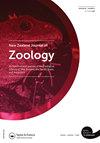Microbial signatures of vertebrate visitation in floral nectar: a case study with two endemic Aotearoa New Zealand plant species
IF 1.1
4区 生物学
Q3 ZOOLOGY
引用次数: 0
Abstract
Microbes found in nectar and dispersed by animal visitors can mediate pollination and host fitness. While previous studies have characterised floral nectar microbiomes and their effects on invertebrate pollinators, fewer studies have focused on vertebrate pollinators, especially outside of the Northern Hemisphere. In Aotearoa New Zealand, vertebrates, such as birds and bats, are critical pollinators for many native plant species. Here, we present nectar microbiome profiles for two endemic, vertebrate-pollinated plant species in Aotearoa New Zealand, wharariki, mountain flax (Phormium cookianum), and pua o te Rēinga, wood rose (Dactylanthus taylorii). We used vertebrate exclusion treatments and camera traps to monitor visitation. Camera trap footage revealed silvereye (Zosterops lateralis), ship rat (Rattus rattus), and possum (Trichosurus vulpecula) visitation. We detected shifts in microbial species turnover in wood rose and varying relative abundances of fungal and bacterial taxa across the vertebrate exclusion treatments for both mountain flax and wood rose. However, we did not detect strong effects on floral nectar microbiome community composition or richness. Future work should move beyond profiling the microbial communities and identify fitness consequences and pollination outcomes, which could affect conservation and management decisions.脊椎动物访花花蜜的微生物特征:两种新西兰奥特罗阿特有植物的案例研究
在花蜜中发现并由动物访客传播的微生物可以调节授粉和宿主的适应性。虽然以前的研究已经描述了花蜜微生物群及其对无脊椎动物传粉媒介的影响,但很少有研究关注脊椎动物传粉媒介,特别是在北半球以外的地区。在新西兰奥特罗阿,脊椎动物,如鸟类和蝙蝠,是许多本地植物物种的重要传粉者。在这里,我们展示了新西兰Aotearoa地区两种特有的脊椎动物传粉植物的花蜜微生物群特征,即warariki, mountain亚麻(Phormium cookianum)和pua o the Rēinga,木玫瑰(Dactylanthus taylorii)。我们采用脊椎动物隔离处理和相机陷阱来监测访客。摄像机捕捉到银眼鼠(Zosterops lateralis)、船鼠(Rattus Rattus)和负鼠(Trichosurus vulpecula)来访。我们检测了木玫瑰中微生物种类更替的变化以及真菌和细菌分类群的相对丰度在山麻和木玫瑰脊椎动物排除处理中的变化。然而,我们没有发现对花蜜微生物群落组成或丰富度的强烈影响。未来的工作应该超越对微生物群落的分析,并确定适应性结果和授粉结果,这可能会影响保护和管理决策。
本文章由计算机程序翻译,如有差异,请以英文原文为准。
求助全文
约1分钟内获得全文
求助全文
来源期刊
CiteScore
2.80
自引率
0.00%
发文量
20
审稿时长
>12 weeks
期刊介绍:
Aims: The diversity of the fauna of the southern continents and oceans is of worldwide interest to researchers in universities, museums, and other centres. The New Zealand Journal of Zoology plays an important role in disseminating information on field-based, experimental, and theoretical research on the zoology of the region.

 求助内容:
求助内容: 应助结果提醒方式:
应助结果提醒方式:


